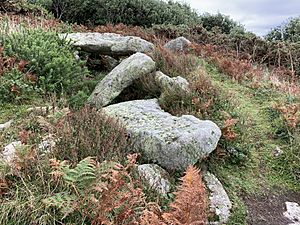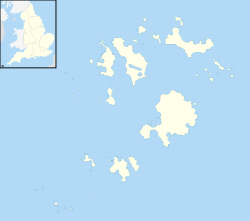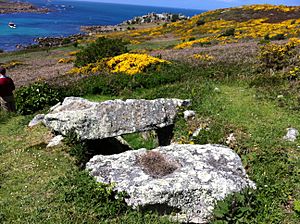Obadiah's Barrow facts for kids

A view of Obadiah's Barrow
|
|
| Location | Gugh, Isles of Scilly |
|---|---|
| Coordinates | 49°53′44″N 6°20′05″W / 49.895594°N 6.334838°W |
| Type | Burial chamber |
| History | |
| Founded | c.2500-1000 BC |
| Official name | Obadiah's Barrow |
| Reference no. | 303188 |
Obadiah's Barrow, also called Obadiah's Grave, is a very old burial place on the island of Gugh in the Isles of Scilly. It is a special type of tomb known as a Neolithic entrance grave. This means it was built by people living in the Neolithic era, or New Stone Age. This ancient grave sits on a hillside called Kittern Hill, which is the highest point on Gugh. A British archaeologist named George Bonsor explored it in 1901.
Contents
What is Obadiah's Barrow?
Obadiah's Barrow is a Neolithic entrance grave. It is about 22 feet (7 meters) wide and 2 feet (0.6 meters) high. You can find it on Gugh, which is one of six islands in the Isles of Scilly where people live.
Location and Size
The grave is on the southwestern side of Kittern Hill. This is the highest point on Gugh island. Kittern Hill has several other ancient burial mounds. There are five entrance graves there, and Obadiah's Barrow is the largest one.
Inside the Grave
Obadiah's Barrow is mostly round, about 33 feet (10 meters) across and 4.9 feet (1.5 meters) tall. It has a short path that leads to an inner room, or chamber. This chamber is about 17 feet (5.2 meters) long and 4.6 feet (1.4 meters) wide. The walls of the chamber are 3.6 feet (1.1 meters) high and have stone slabs at the bottom.
There are four large stone slabs that used to cover the top of the chamber. Two of these have fallen inside. Big stones partly block the entrance to the chamber.
History of the Isles of Scilly Graves
The Isles of Scilly were first settled a very long time ago, around 2500 BC. The burial monuments on these islands were built between the late Neolithic period and the Middle Bronze Age (about 2500-1000 BC). More than eighty entrance graves have been found across the Isles of Scilly.
What is an Entrance Grave?
Entrance graves are special because of how their burial chambers are built. They often use stone slabs placed on their edges, or walls made of stacked stones. Large slabs usually form the roof. You can usually get into the chamber through an opening in the stone edge of the mound. When archaeologists have dug up other entrance graves, they often find pots with ashes, pieces of pottery, and human bones.
Discoveries at Obadiah's Grave
In 1901, the British archaeologist George Bonsor dug up Obadiah's grave. He found a skeleton of a man in the middle of the chamber. He also found a Bronze Age pot for ashes and pieces of other pots. Near the entrance, Bonsor discovered a bronze tool called an awl, more pot pieces, and both burnt and unburnt human bones.
The grave was named after Obadiah Hicks. He was a farmer on St. Agnes island where Bonsor stayed during his work. Bonsor's detailed drawings and plans of the grave still exist today. They give us a great look at the chamber and what was found inside.



